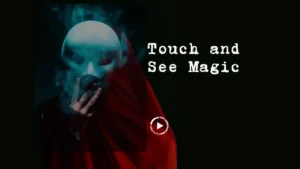
Magic has always been a fascinating subject, captivating audiences with the promise of the impossible made possible. One of the most intriguing aspects of magic is the sensory deception it involves, particularly through touch. The phrase “touch and see magic” encapsulates a form of illusion where the sense of touch is manipulated to create a magical experience. This article delves into the art of touch-based magic, exploring how it works and why it continues to enchant spectators.
The Mechanics of Touch-Based Magic
Fundamental to touch-based magic is the idea of deception and controlling senses. Magicians produce illusions that trick the sense of touch using a variety of approaches. One well-known trick is the “Invisible Touch Trick,” in which a magician appears to touch a volunteer while simultaneously feeling the touch on someone else who has their eyes closed6. This trick depends on the audience not noticing invisible threads or other subtle tactile contact.
Another illustration is the “Psychic Touch” magic trick, in which a magician appears to have physical effect over items. This may entail manipulating items within an airtight enclosure or mentally bending metal.
The key to these tricks is the careful control of the audience’s attention and the use of hidden mechanisms or sleight of hand.
Illusion and perception dance delicately together in the world of magic.extend_more Magicians, akin to contemporary bards, craft stories of awe, manipulating reality through deception and a hint of psychology.extend_more However, the real magic is found not only in the tricks themselves but also in our own minds, where touch and sight shape perception.
In the repertory of the illusionist, touch—often regarded as the sense that is most underappreciated—has a major part. It’s the sense that helps us stay grounded in reality by enabling us to recognize the coolness of metal, the firmness of wood, and the softness of silk.
The Psychology Behind the Illusion
Touch-based magic’s potency stems from its capacity to penetrate human psychology. Our impression of reality is closely linked to our sense of touch. When a magician plays with this feeling, it throws doubt on our perception of reality. A feeling of astonishment and amazement results from the brain’s attempt to make sense of the contradicting facts.
Furthermore, audience participation is frequently involved in touch-based magic, which heightens the illusion. When volunteers participate in the trick, their responses and affirmations of the “magical” touch give the performance legitimacy and strengthen its persuasiveness for the audience as a whole.
These expectations can be used by a talented magician to produce entertaining illusions. Consider a volunteer holding a smooth object while wearing a blindfold. With a flourish, the magician swaps it out for something more rugged. The volunteer experiences a metamorphosis that has all the makings of real magic, based just on touch.
An additional illustration is the “Misdirection Turnover.” The magician raises an object in the air with expert ease, and then it disappears in an instant. The key? When the other hand performs a deft flourish, our eyes are diverted, making the thing appear hidden or palmed. Our attention is briefly drawn to the magician’s partner.
But vision is still the magician’s canvas. The ability of our brains to digest visual information quickly is innate, and magicians skillfully take advantage of this ability extend more Through the manipulation of perspective, movement, or light, they deceive our minds into perceiving objects that aren’t actually there extend more The old-fashioned “Cut and Restored Rope” trick is a great example of this. With a flourish, the magician seems to cut the rope in half, but then it magically comes back whole. In reality, the “cut” section might be cleverly hidden, or perhaps the rope itself is a cleverly designed duplicate.
The Enduring Appeal of Magic
Magic has always had a magnetic appeal. It appeals to people of all ages, backgrounds, and languages and satisfies their innate curiosity about the unknown. Especially touch-based magic has a certain allure. It’s important to feel an illusion rather than merely observe it. The captivating and unforgettable quality of touch-based magic lies in its multimodal experience.
The straightforward yet profound experience of touch-based magic reminds us of the delight of human connection and the excitement of the unexplained in a world where technology frequently rules our senses. It’s evidence of magic’s continuing ability to uplift, amuse, and arouse awe in children.
Conclusion
“Touch and see magic” is more than just a phrase; it’s a gateway to an enchanting world where our senses are playfully challenged, and our perceptions are cleverly deceived. Through the art of illusion and the psychology of perception, magicians continue to captivate audiences with their touch-based wonders. Whether it’s the invisible touch trick or the psychic influence of objects, the magic of touch remains a beloved and mesmerizing art form that continues to delight and surprise us all.